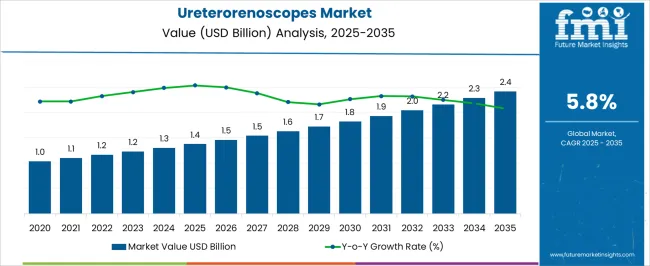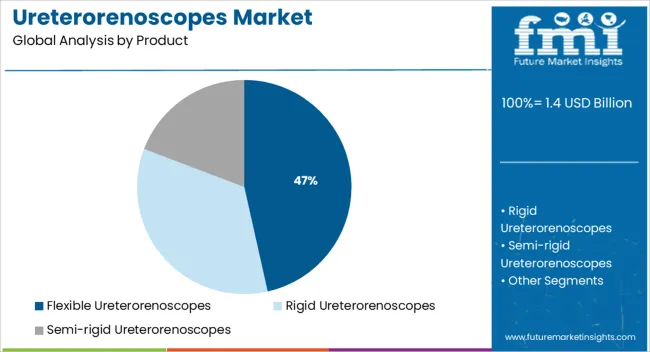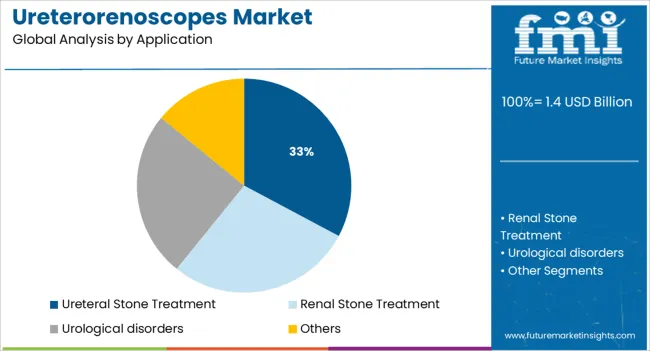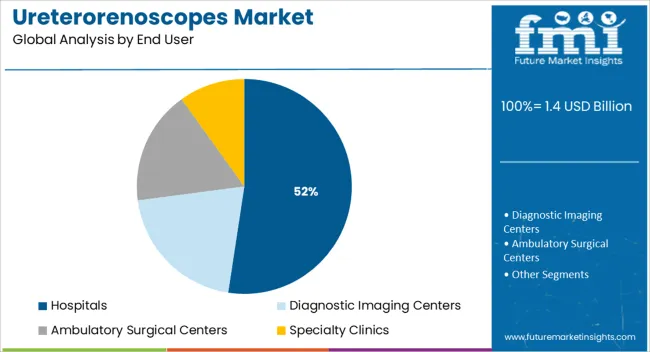The Ureterorenoscopes Market is estimated to be valued at USD 1.4 billion in 2025 and is projected to reach USD 2.4 billion by 2035, registering a compound annual growth rate (CAGR) of 5.8% over the forecast period.

| Metric | Value |
|---|---|
| Ureterorenoscopes Market Estimated Value in (2025 E) | USD 1.4 billion |
| Ureterorenoscopes Market Forecast Value in (2035 F) | USD 2.4 billion |
| Forecast CAGR (2025 to 2035) | 5.8% |
The ureterorenoscopes market is progressing steadily, supported by increasing incidences of urolithiasis, a rise in endoscopic stone management procedures, and broader adoption of minimally invasive urology across global healthcare systems. The growing preference for endoscopic over open surgical interventions is being influenced by faster recovery times, lower post-operative complications, and increased cost-effectiveness for both providers and patients. Technological innovations in digital optics, deflection mechanics, and smaller diameter scopes have significantly improved the diagnostic and therapeutic precision of ureterorenoscopy.
Additionally, improvements in laser lithotripsy compatibility and maneuverability are reinforcing the clinical efficacy of these tools, particularly in treating complex renal and ureteral calculi. Market growth is further supported by expanding healthcare infrastructure, particularly in developing countries, where the demand for advanced urological care is on the rise.
Moreover, clinical training programs and government-backed healthcare investments are contributing to increased procedural volumes Over the forecast period, sustained product innovation, combined with growing awareness about minimally invasive options, is expected to accelerate the adoption of ureterorenoscopes across varied urological applications.
The market is segmented by Product, Application, and End User and region. By Product, the market is divided into Flexible Ureterorenoscopes, Rigid Ureterorenoscopes, and Semi-rigid Ureterorenoscopes. In terms of Application, the market is classified into Ureteral Stone Treatment, Renal Stone Treatment, Urological disorders, and Others. Based on End User, the market is segmented into Hospitals, Diagnostic Imaging Centers, Ambulatory Surgical Centers, and Specialty Clinics. Regionally, the market is classified into North America, Latin America, Western Europe, Eastern Europe, Balkan & Baltic Countries, Russia & Belarus, Central Asia, East Asia, South Asia & Pacific, and the Middle East & Africa.

The flexible ureterorenoscopes segment is expected to account for 46.5% of the total revenue share in the ureterorenoscopes market in 2025, positioning it as the leading product category. The dominance of this segment is attributed to its superior maneuverability and enhanced visualization capabilities that allow deeper access to the upper urinary tract.
These scopes offer improved deflection angles, reduced scope diameter, and compatibility with high-powered laser systems, making them ideal for treating renal calculi and complex ureteral stones. Their growing use in outpatient and ambulatory settings is being supported by better ergonomics, lower patient discomfort, and reduced procedure time.
The rising preference for single-use and digital flexible scopes, which minimize cross-contamination risks and offer improved image resolution, is also influencing procurement decisions by hospitals and surgical centers Additionally, the ability of flexible ureterorenoscopes to accommodate advancements in imaging software and data integration systems further enhances their clinical utility, making them a preferred choice in modern urology departments.

The ureteral stone treatment segment is projected to contribute 32.8% of the overall market revenue in 2025, establishing itself as the primary application area for ureterorenoscopes. This growth is being driven by the increasing global burden of kidney and ureteral stones, influenced by dietary changes, dehydration, and sedentary lifestyles.
Ureterorenoscopy has become a frontline treatment for stone management, favored for its non-invasive nature, minimal blood loss, and high success rates in stone retrieval or fragmentation. Advances in laser lithotripsy, particularly with holmium and thulium fiber lasers, have enhanced the efficiency of ureteral stone removal, supporting the wider use of ureterorenoscopes in this application.
The shift from extracorporeal shock wave lithotripsy to ureteroscopic techniques for mid to distal ureteral stones is further reinforcing this trend Integration of real-time imaging, digital endoscopy, and stone recognition algorithms within SDC-compatible scopes is also contributing to improved procedural outcomes, thereby strengthening the role of ureterorenoscopy in stone treatment pathways.

The hospitals segment is anticipated to represent 52.4% of the ureterorenoscopes market revenue in 2025, making it the most significant end-user category. This leadership position is being supported by high patient inflow, availability of advanced infrastructure, and the presence of skilled urologists in multi-specialty and tertiary care hospitals. Hospitals have been leading adopters of both reusable and single-use flexible ureterorenoscopes, driven by the need for high procedural throughput, clinical safety, and infection control.
Procurement decisions are increasingly guided by total cost of ownership, reprocessing efficiencies, and compatibility with surgical navigation systems. Additionally, hospitals benefit from better access to government and private funding for capital-intensive medical equipment, allowing for regular upgrades and adoption of cutting-edge visualization technologies.
The increasing number of inpatient urological procedures and the integration of robotic-assisted systems have also contributed to higher adoption of advanced scopes within hospital settings As urology departments expand to accommodate growing surgical volumes, hospitals are expected to remain the primary consumers of ureterorenoscopic solutions.
The major factors driving the ureterorenoscopes market are the increasing consumption of alcohol and aerated drinks and less consumption of water that promotes the formation of ureteral and renal stones. Furthermore, the changing lifestyles, improper diet, and lack of exercise lead to the formation of urinary and kidney calculi, which is predicted to propel the market for ureterorenoscopes.
Additionally, the growth in the research and developmental activities, as well as the increasing adoption of technology by the government of most of the developing and developed nations is influencing the ureterorenoscopes market to propel. Moreover, the favorable reimbursement assessment in hospitals and the growing preference for minimally invasive interventional processes among the patient are also attributing to the growth of the ureterorenoscopes market.
Due to the high prevalence of urolithiasis, the high adoption rate of minimally invasive surgeries, the launch of new devices, and developed healthcare infrastructure, North America is expected to share the highest market for ureterorenoscope devices in the projected years.
Europe is the largest market for ureterorenoscope products after North America owing to the rapidly growing geriatric population, increasing number of kidney stone treatment procedures, development of advanced medical devices, and favourable reimbursement policies.
Furthermore, due to the increasing prevalence of ureteral and renal stones by less consumption of water, changing dietary habits and lack of exercise, and increasing healthcare awareness the Asia Pacific region is expected to develop a lucrative market for ureterorenoscope in near future.
Some of the market players operating in the ureterorenoscopes market are Boston Scientific Corporation, Olympus Corporation, Stryker, Richard Wolf GmbH, PENTAX Medical, KARL STORZ SE Co. KG, Elmed Electronics Medical Industry Trade Inc., AED.MD, ProSurg Inc., Dornier MedTech., and Erbe Elektromedizin GmbH.
| Report Attributes | Details |
|---|---|
| Growth Rate | CAGR of 5.8% 2025 to 2035 |
| Base Year for Estimation | 2024 |
| Historical Data | 2012 to 2024 |
| Forecast Period | 2025 to 2035 |
| Qualitative Units | Revenue in USD Billion, Volume in Units and CAGR from 2025 to 2035 |
| Report Coverage | Revenue Forecast, Volume Forecast, Company Ranking, Competitive Landscape, Growth Factors, Trends and Pricing Analysis |
| Segment Covered | Product, Application, End User, Region |
| Region Covered | North America; Latin America; Europe; East Asia; South Asia; Oceania; Middle East Africa |
| Key Countries Profiled | USA, Canada, Brazil, Mexico, Germany, UK, France, Spain, Italy, China, Japan, South Korea, Malaysia, Singapore, Australia, New Zealand, GCC, South Africa, Israel |
| Key Players | Boston Scientific Corporation; Olympus Corporation; Stryker; Richard Wolf GmbH; PENTAX Medical; KARL STORZ SE Co. KG; Elmed Electronics Medical Industry Trade Inc.; AED.MD; ProSurg Inc.; Dornier MedTech.; Erbe Elektromedizin GmbH |
| Customization | Available Upon Request |
The global ureterorenoscopes market is estimated to be valued at USD 1.4 billion in 2025.
The market size for the ureterorenoscopes market is projected to reach USD 2.4 billion by 2035.
The ureterorenoscopes market is expected to grow at a 5.8% CAGR between 2025 and 2035.
The key product types in ureterorenoscopes market are flexible ureterorenoscopes, rigid ureterorenoscopes and semi-rigid ureterorenoscopes.
In terms of application, ureteral stone treatment segment to command 32.8% share in the ureterorenoscopes market in 2025.






Full Research Suite comprises of:
Market outlook & trends analysis
Interviews & case studies
Strategic recommendations
Vendor profiles & capabilities analysis
5-year forecasts
8 regions and 60+ country-level data splits
Market segment data splits
12 months of continuous data updates
DELIVERED AS:
PDF EXCEL ONLINE

Thank you!
You will receive an email from our Business Development Manager. Please be sure to check your SPAM/JUNK folder too.
Chat With
MaRIA